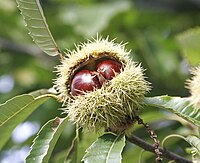
Photo from wikipedia
Leaf extract of Cydonia Oblonga Mill. is interesting for further exploration of the potential of its substrates for therapeutic supplements. Quantitative and qualitative analyses were conducted on samples of green… Click to show full abstract
Leaf extract of Cydonia Oblonga Mill. is interesting for further exploration of the potential of its substrates for therapeutic supplements. Quantitative and qualitative analyses were conducted on samples of green (October), yellow (November), and brown (December) quince leaves collected in the region of Pinhel, Portugal. Mineral analysis determined the measurements of the levels of several macro- and micro-elements. Organic analysis assessed the moisture content, total phenolic content (TPC), vitamin E, and fatty acid (FA) profiles. Mineral analysis was based on ICP-MS techniques, while the profiles of vitamin E and FA relied on HPLC-DAD-FLD and GC-FID techniques, respectively. Moisture content was determined through infrared hygrometry and TPC was determined by spectrophotometric methods. Regarding the mineral content, calcium, magnesium, and iron were the most abundant minerals. Concerning organic analysis, all leaf samples showed similar moisture content, while the TPC of gallic acid equivalents (GAE) and total vitamin E content, the most predominant of which was the α-tocopherol isomer, showed significant variations between green-brown and yellow leaves. FA composition in all leaf samples exhibited higher contents of SFA and PUFA than MUFA, with a predominance of palmitic and linolenic acids. Organic and inorganic analysis of quince leaves allow for the prediction of adequate physiological properties, mainly cardiovascular, pulmonary, and immunological defenses, which with our preliminary in silico studies suggest an excellent supplement to complementary therapy, including drastic pandemic situations.
Journal Title: Plants
Year Published: 2022
Link to full text (if available)
Share on Social Media: Sign Up to like & get
recommendations!